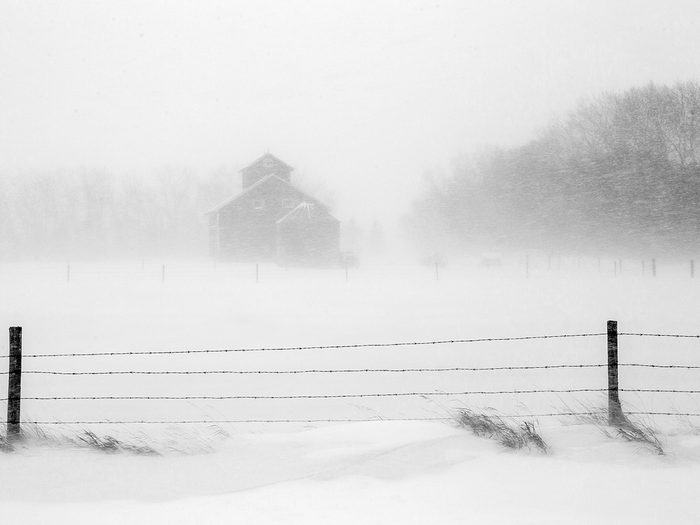
The Ides of March Blizzard, Saskatchewan and Manitoba
March 15, 1941
What began as a warm and sunny spring Saturday quickly turned into one of the worst snowstorms in Canada’s history, as an unexpected blizzard ripped through parts of Saskatchewan, Manitoba, and the Upper Midwest states, whipping up winds of over 100 kilometres an hour and killing 76 people in just seven hours.
It was a devastating type of snowstorm called an “Alberta clipper,” a fast-moving cold front sweeping in from the Rockies that brought whiteout conditions and ferocious wind chills of -45°C out of nowhere. Dressed for spring, many of the victims died of exposure after they left their stalled cars on the road and tried to walk to safety. This tragedy is said to be the main reason authorities now urge you not to leave your car if you’re stranded in a blizzard on the highway.
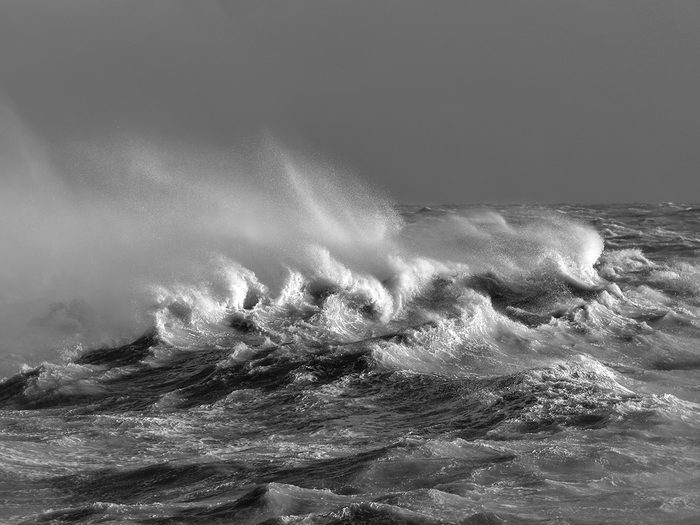
The Pollux-Truxtun Disaster, Newfoundland
February 18, 1942
A hurricane-force snowstorm, a massive shipwreck, a daring cliff rescue, a warm-hearted community, and a triumph against prejudice… The story of Newfoundland’s worst blizzard is worthy of a blockbuster movie. U.S. Navy destroyers Pollux, Truxtun and Wilkes were en route to a military base at Argentia, Newfoundland, when they strayed off course in a whiteout blizzard and crashed into rocks on the shoreline. More than 200 sailors drowned, and many of the survivors were hauled up a 200-foot cliff on a swaying bosun’s chair, pulled by villagers from nearby St. Lawrence.
The wreck’s most famous survivor was Lanier Phillips, a 19-year-old Black deck hand from Georgia who was taken in by a local family and nursed back to health. Used to the extreme racism he’d grown up with in the South, Phillips was moved by their kindness, and went on to become a prominent Civil Rights activist and oceanographer, returning to St. Lawrence to fund a scholarship and a children’s playground.
Read up on the most famous shipwrecks in Canadian history.
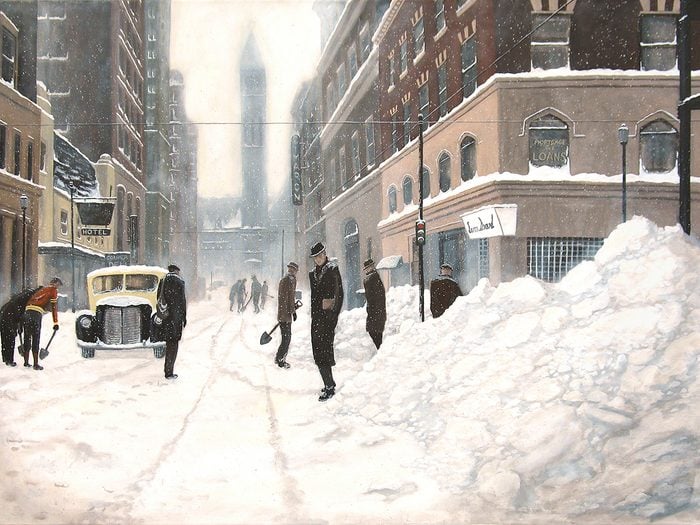
The Great Toronto Snowstorm
December 11, 1944
The weather forecast called for light snow that day, but Toronto got more than it bargained for, with a record 57 centimetres dumped over most of the city. Traffic was paralyzed for days, cutting off vital deliveries of milk, bread and coal, while important munitions factories supplying the war effort had to shut down.
Fierce winds overturned a streetcar at Queen St. East and Mutual St., trapping 170 people inside and crushing one to death. In total, 21 people died across Southern Ontario, 13 of them from heart attacks caused by overexertion as they tried to shovel their way out of their homes. The city’s plows were no match for the huge snow drifts, and the Mayor appealed for young volunteers for help clear the streets. It ultimately took three days for Torontonians to dig themselves out.
Here are seven mistakes to avoid when shovelling snow.
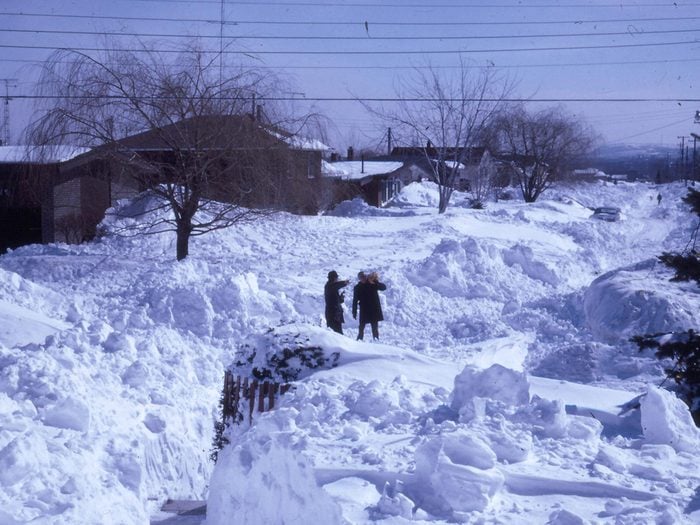
The Storm of the Century, Quebec
March 4, 1971
The winter of 1970-71 was an epic one, even by Montreal standards. The city already had a half-metre of snow on the ground by the time the March 4 storm hit, and 47 more centimetres would fall that day, with wind gusts of 110 kilometres per hour. Impassable roads meant residents could only get around on foot or by snowshoes, skis, and the underground metro trains. Two hundred Ski-Doo owners mobilized to provide emergency transport, rescuing trapped motorists and ferrying people to hospital.
A few weren’t so lucky—12 Montrealers died from collisions, cold or suffocation in their cars, some buried so deep they only had their antennas showing. A total of 500,000 truckloads of snow were hauled out of the city, only to have another smaller blizzard hit three days later. The total snowfall that winter was almost four metres.
Find out why historians refer to 1816 as the “year Canada didn’t have a summer“.
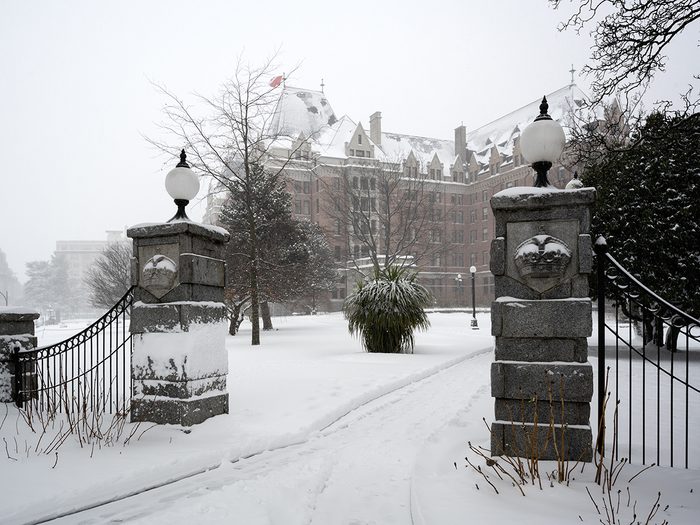
Blizzard of ’96, British Columbia
December 29, 1996
Snowfalls are rare in balmy Victoria, but that doesn’t mean they never happen—and that fateful Sunday, residents opened their doors only to be met with a wall of snow. Sixty-five centimetres fell over the southwest of British Columbia in a single day, causing the roof of the B.C. Stadium to buckle. Over five days the total came to 125 centimetres, paralyzing transit and emergency response services. In the Fraser Valley, 250 motorists were stranded for up to 17 hours in drifts as high as three metres, and the military was called in to provide what provincial authorities called “the most significant and intense life-saving operation carried out in British Columbia in many years.”
Glen and Cheryl Tolsma welcomed 89 surprise guests at their farm east of Abbotsford, as stranded travellers poured in from the highways seeking food, shelter and warmth. “When something bad happens, you just help,” Cheryl told a local reporter. “Luckily we had lots of food and toilet paper.”
Find out what it was like on the coldest day in Canadian history.
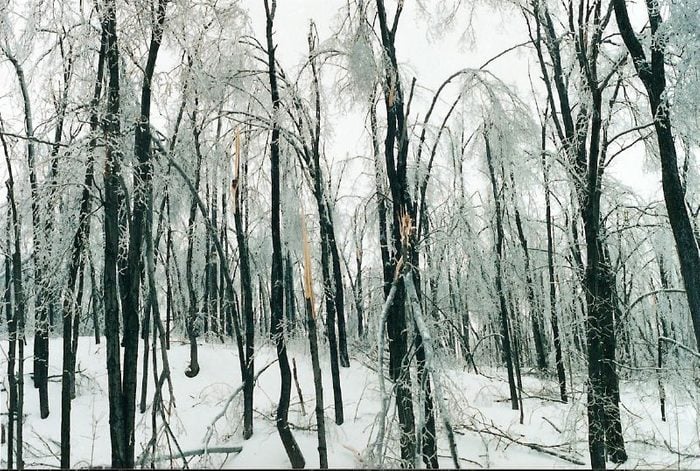
The Ice Storm, Ontario, Quebec and New Brunswick
January 4-9, 1998
What Environment Canada called one of the most destructive and disruptive storms in Canadian history—and one of our all-time worst natural disasters—was actually five successive ice storms along a corridor from Kingston through Ottawa and Montreal to southern New Brunswick, adding layer upon layer of freezing rain up to 10 centimetres thick. More than 1,000 steel hydro transmission towers crumpled under the weight of the ice, cutting off power to 4 million homes for as long as four weeks. More than 250 communities were declared disaster areas, forcing 100,000 people from their homes and prompting the largest-ever peacetime deployment of Canadian troops to clear roads and assist emergency responders.
Thirty-five people died as a result of the ice storm, many from carbon monoxide poisoning after firing up barbecues or gas-powered generators indoors. A later inquiry found that Quebec’s power grid and emergency management system were woefully unprepared—including Montreal’s water filtration plant, which barely averted a public health catastrophe when it lost power for several hours. Public Safety Canada now recommends keeping at least 12 litres of drinking water on hand per person, enough for three days.
Here’s more expert advice on how to prepare for a natural disaster.
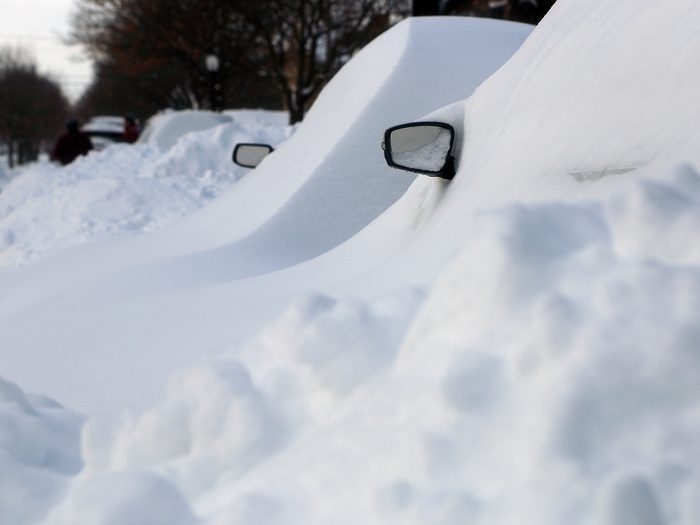
The Blizzard of 1999, Ontario
January 13-15, 1999
This snowstorm lives in infamy for Toronto mayor Mel Lastman’s decision to call in the army to shovel the sidewalks. Indeed, the image of Lastman fist-pumping as he rode atop an armoured truck was an iconic moment in Toronto history, much to the amusement of the rest of Canada. But the reality was a bona fide emergency, affecting more than 7 million people across southern Ontario. Several storms within two weeks dumped a total of 119 centimetres of snow—beating a record from 1846—and shut down much of the city’s transit system, closing schools, and cancelling flights.
When the weather forecast threatened yet another blizzard, 400 troops from CFB Petawawa rolled into the city in Bison armoured vehicles and set to work clearing the streets and helping transport the sick and injured to hospital. More than a hundred volunteers also drove 20 hours from Prince Edward Island with snow plows, at a time when Toronto didn’t have adequate equipment of its own. The following winter, St. John’s, Newfoundland, got more than 600 centimetres of snow—and managed without the army’s help.
Snow isn’t always unwelcome, of course. Check out this stunning gallery of Canadian winter photography.

Snowmageddon, Ontario
December 12-14, 2010
Highway 402 between Sarnia and London was a scene of chaos over two days in December of 2010 as a severe snow streamer with heavy winds stranded hundreds of drivers overnight. The “lake effect”—a climate phenomenon that can generate narrow bands of intense snow—can cause visibility to go from clear to zero in seconds, wreaking havoc of biblical proportions along a 30-kilometre stretch of the highway. Two hundred tractor-trailers and more than a hundred cars were stuck in deep snow, prompting Lambton County officials to declare a state of emergency and call in help from the military.
Snowmobiles, rescue helicopters and snowplows towing buses managed to pluck travellers from their buried cars, many having gone without food, medication or warm clothing for 48 hours. Others sought shelter along the highway, where local homeowners didn’t hesitate to welcome strangers in need.
Don’t miss these natural disaster survival tips from a Canadian Red Cross volunteer.
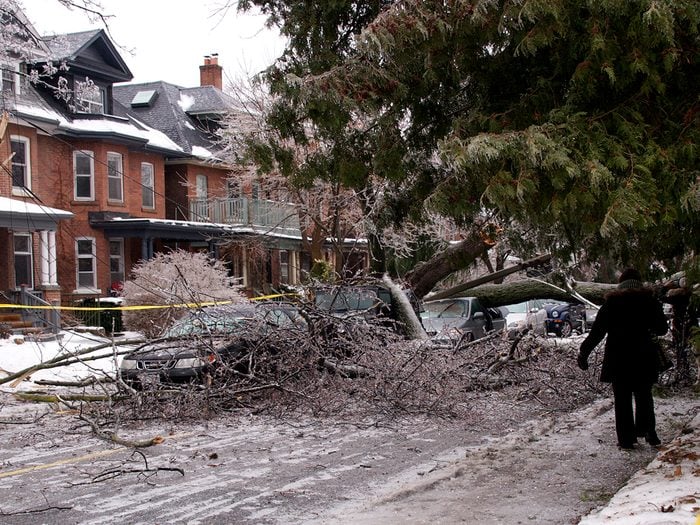
December 2013 Ice Storm, Southern Ontario, Quebec and New Brunswick
December 20, 2013
Many remember the winter of 2013-2014 as the year of the polar vortex, when blasts of Arctic winds disrupted weather patterns as far south as Texas. A few days before Christmas, a storm complex inflicted all kinds of severe weather across the continent, including a tornado outbreak and an ice storm to rival the tempest of ’98. (Read up on the worst tornado in Canadian history.)
Freezing rain, ice pellets and snow damaged power lines in Southern Ontario, Quebec and New Brunswick, causing outages that affected a million homes across eastern Canada, with many spending Christmas Eve in the dark. In New Brunswick, power was not restored to some residents until January 3. Eleven people died, either from car collisions or carbon monoxide poisoning, and the total damages exceeded $200 million.
Find out which city is the hailstorm capital of Canada.
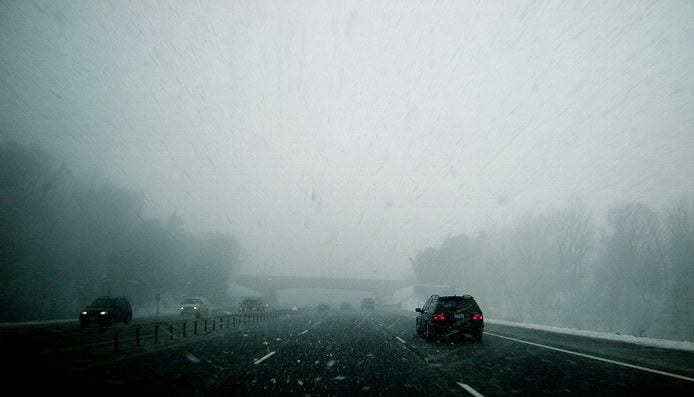
April Blizzard of 2018, Southern Ontario, Quebec and New Brunswick
April 17, 2018
When Wiarton Willie, Ontario’s official weather-prognosticating groundhog, predicted six more weeks of winter in 2018, he really meant it—Ontario and Quebec were hit with heavy snow, fierce winds and falling ice just as residents were gearing up for T-shirt weather. Up to 40 centimetres of snow plus freezing rain and ice pellets caused 1,800 car collisions, including a 50-car pileup on Highway 400 near Barrie.
Large sheets of ice sliding off roofs created hazards for passersby, as well as shattering Parliament building windows in Ottawa and even piercing the dome of the Rogers Centre in Toronto. As the storm continued east, New Brunswick experienced the worst floods in recent history as the Saint John River overflowed from fast-melting snow.
Next, take a look back at the worst natural disasters in Canadian history.